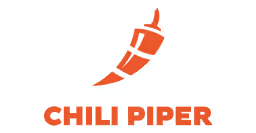OpenPhone Alternatives
Searching for OpenPhone alternatives? This guide analyzes 10 other VoIP providers, comparing features and pricing to inform your decision.

Many teams choose OpenPhone, and for good reason. It’s a solid choice for a simple, shared business number. Users like its clean interface and collaborative features that help keep team communication organized and separate from personal calls.
But no tool is perfect. Some users note that customer support can be slow or that it lacks advanced features for larger teams. So, we analyzed the top alternatives based on G2 reviews to help you find the right fit. Let's get started.
11x: Digital Workers for Sales Teams
If your goal is to add digital workers to your sales team for outbound calls and appointment sets, 11x offers a specific solution. It is built for teams that want to automate certain sales functions rather than handle general business communication.
We offer a GTM platform where AI agents manage the sales process. 11x uses these agents to handle various sales functions automatically.
Our AI agent, Alice, identifies prospects, conducts outreach on email and LinkedIn, and updates your CRM. Another agent, Julian, qualifies inbound leads and schedules meetings.
Our platform replaces separate tools for data enrichment, outreach, and email warmup. We combine these functions into a single solution.
OpenPhone Alternatives
Here is a detailed review of the top OpenPhone alternatives. Each option is analyzed based on its pricing, main features, and specific pros and cons when compared to OpenPhone.
1) RingCentral MVP
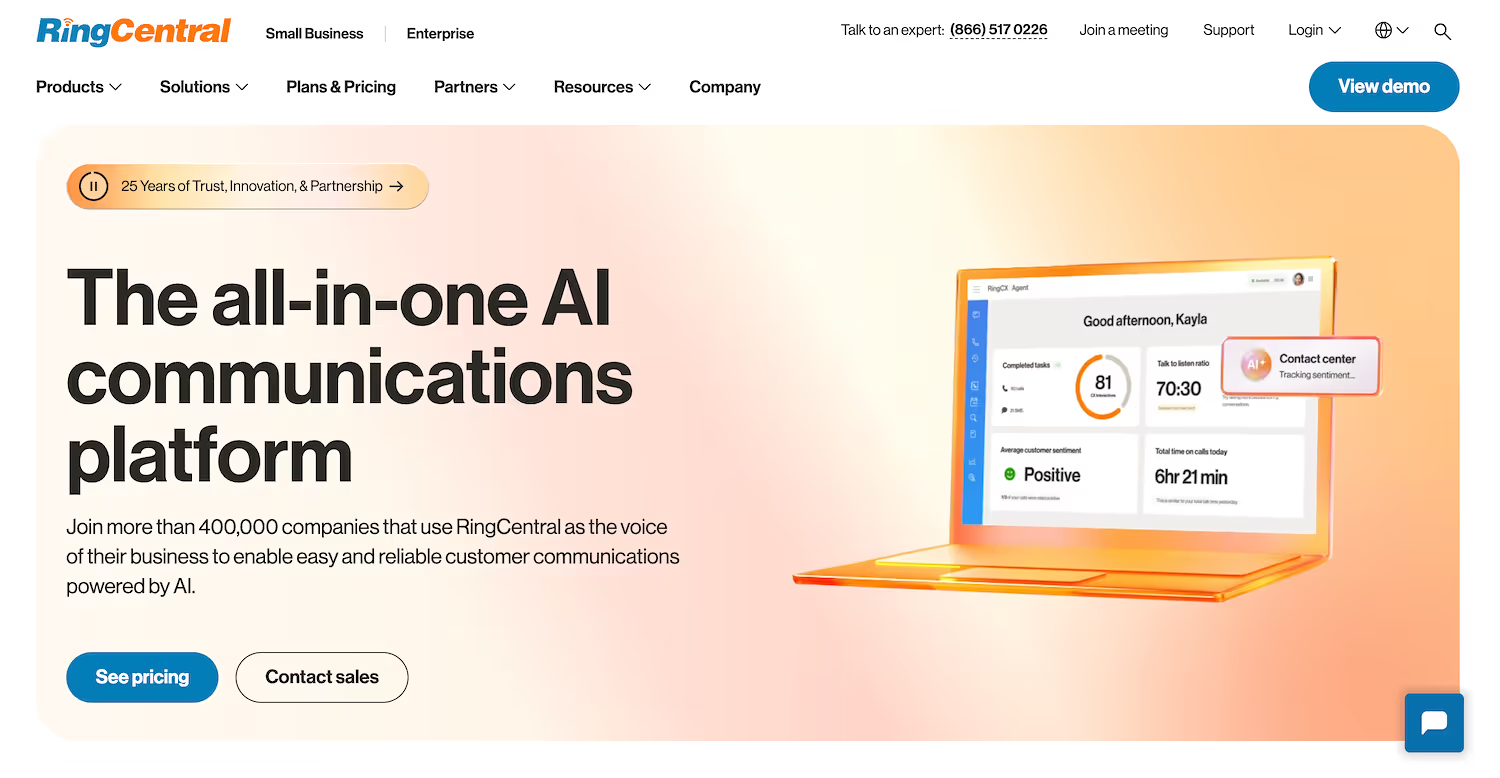
RingCentral MVP is a unified communications platform that combines phone, video, and messaging into one application. It is built for businesses that need a single tool for all communication. Compared to OpenPhone, it provides a wider set of features. This makes it a common choice for larger teams or companies that plan for growth and need more than a basic phone dialer.
RingCentral MVP's Main Features
- The platform integrates phone calls, video meetings, and team messaging into a single application.
- It includes features designed to support larger teams and scale with company growth.
How RingCentral MVP Compares to OpenPhone
Average Review Score: 4.0/5 stars based on 154 G2 reviews.
- RingCentral offers an omnichannel solution with voice and over 30 digital channels, a wider range compared to OpenPhone's focus on calls and SMS.
- It provides access to more than 300 prebuilt integrations, which allows for more complex workflows than the connections available with OpenPhone.
- The platform includes advanced AI options like bots and Intelligent Virtual Agents for self-service, a level of automation not found in OpenPhone.
- Its AI-powered analytics offer detailed workforce management insights, a more robust solution for performance tracking compared to the simpler analytics in OpenPhone.
Where RingCentral MVP Falls Short
- RingCentral MVP's setup can be complex, sometimes taking up to two months. This is a longer process compared to OpenPhone, which offers a faster setup for teams that need a quick start.
- The platform is generally more expensive than OpenPhone. Its extensive features come at a higher price point, which might not be cost-effective for small businesses that only need basic phone functionalities.
- Some users find its interface less intuitive than OpenPhone's clean design. The navigation can sometimes feel overwhelming for teams accustomed to a more straightforward tool with fewer features.
Pricing and Cost-Effectiveness
RingCentral MVP is generally more expensive than OpenPhone, reflecting its broader feature set. For the most accurate pricing, we recommend visiting RingCentral's official website, as costs vary based on your team's specific needs.
2) Dialpad Ai Voice
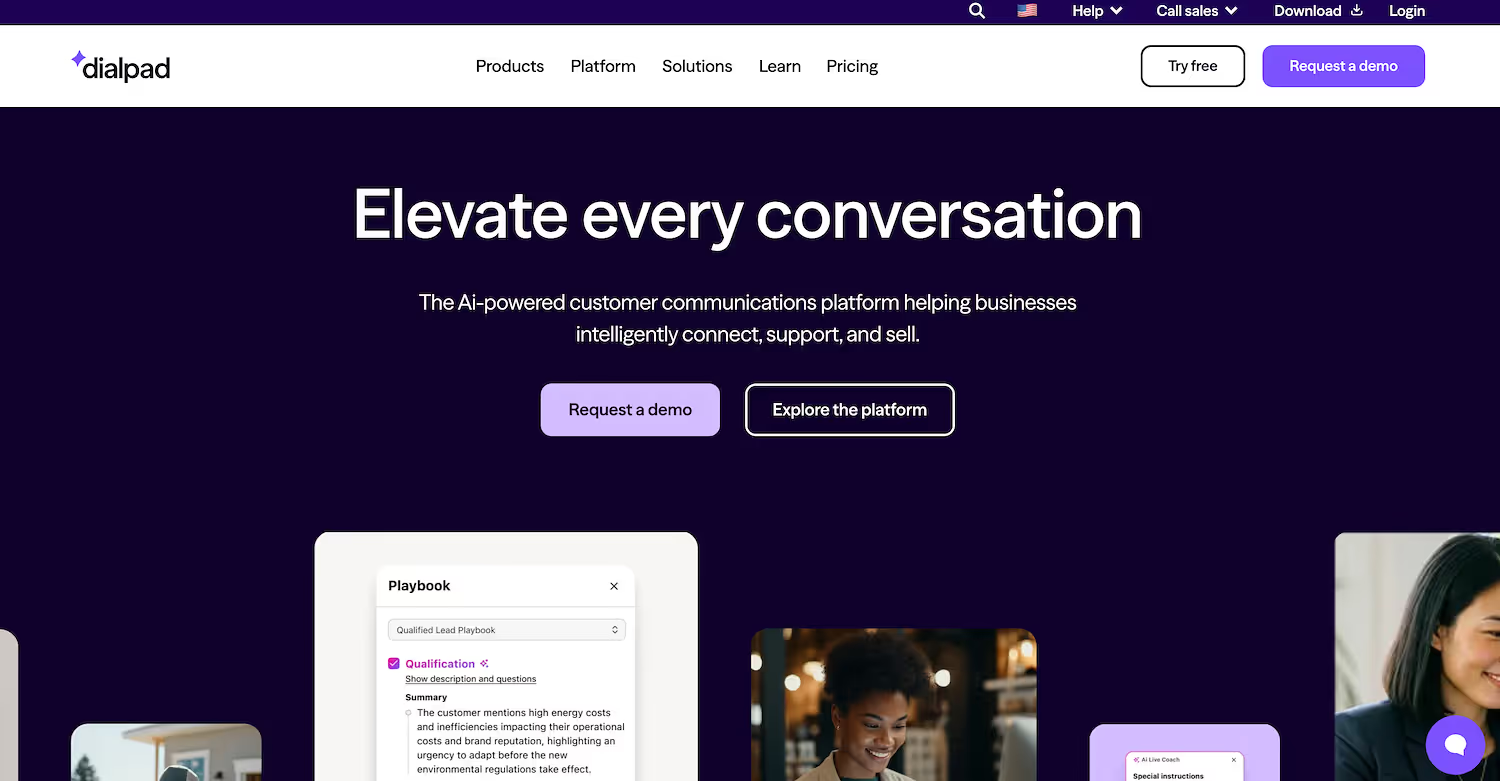
Dialpad Ai Voice is an AI-powered customer-communications platform. It combines phone calls, messages, video meetings, and contact center tools into one application. The platform uses its own large language model for real-time transcriptions, summaries, and analytics.
It serves over 30,000 customers and helps companies unify multiple phone providers onto a single cloud platform. The solution is for businesses that want to connect, support, and sell with one tool.
Dialpad Ai Voice's Main Features
- The platform's core AI layer provides real-time transcription, sentiment analysis, CSAT scoring, and automated action-item extraction.
- It includes an outbound sales dialer with real-time AI coaching, performance insights, and workflow automations.
- The system offers contact center capabilities, including AI agents, live coaching for support staff, and deep analytics.
- It integrates with business applications like Salesforce, Zendesk, and Microsoft Teams through its app marketplace.
How Dialpad Ai Voice Compares to OpenPhone
Average Review Score: 4.4/5 stars based on 3,901 G2 reviews.
- Dialpad provides real-time AI features like call transcriptions and automated summaries, which gives more in-call support than OpenPhone's standard functions.
- The platform unifies calls, messages, and video meetings in a single application, while OpenPhone focuses primarily on phone calls and SMS.
- It uses a proprietary AI model trained on extensive conversational data for higher accuracy, a more advanced approach than the analytics available in OpenPhone.
- The tool integrates with applications like Google Workspace and Microsoft 365, which allows for a more connected workflow than OpenPhone's simpler connections.
Where Dialpad Ai Voice Falls Short
- Dialpad's pricing structure sometimes includes added fees for SMS messaging, which differs from OpenPhone where messaging is a core part of its packages.
- Some administrators report a learning curve with the platform's setup due to its many features, while OpenPhone provides a more direct user experience.
- Users occasionally mention connection glitches or issues with call transfers, which can sometimes occur with more complex systems compared to a simpler tool like OpenPhone.
Pricing and Cost-Effectiveness
Dialpad's Standard plan is $15 per user per month when billed annually, while its Pro plan is $25. This is generally higher than OpenPhone, but the cost covers advanced AI features that the simpler alternative lacks. For the most accurate pricing, visit Dialpad Ai Voice's official website.
3) Aircall
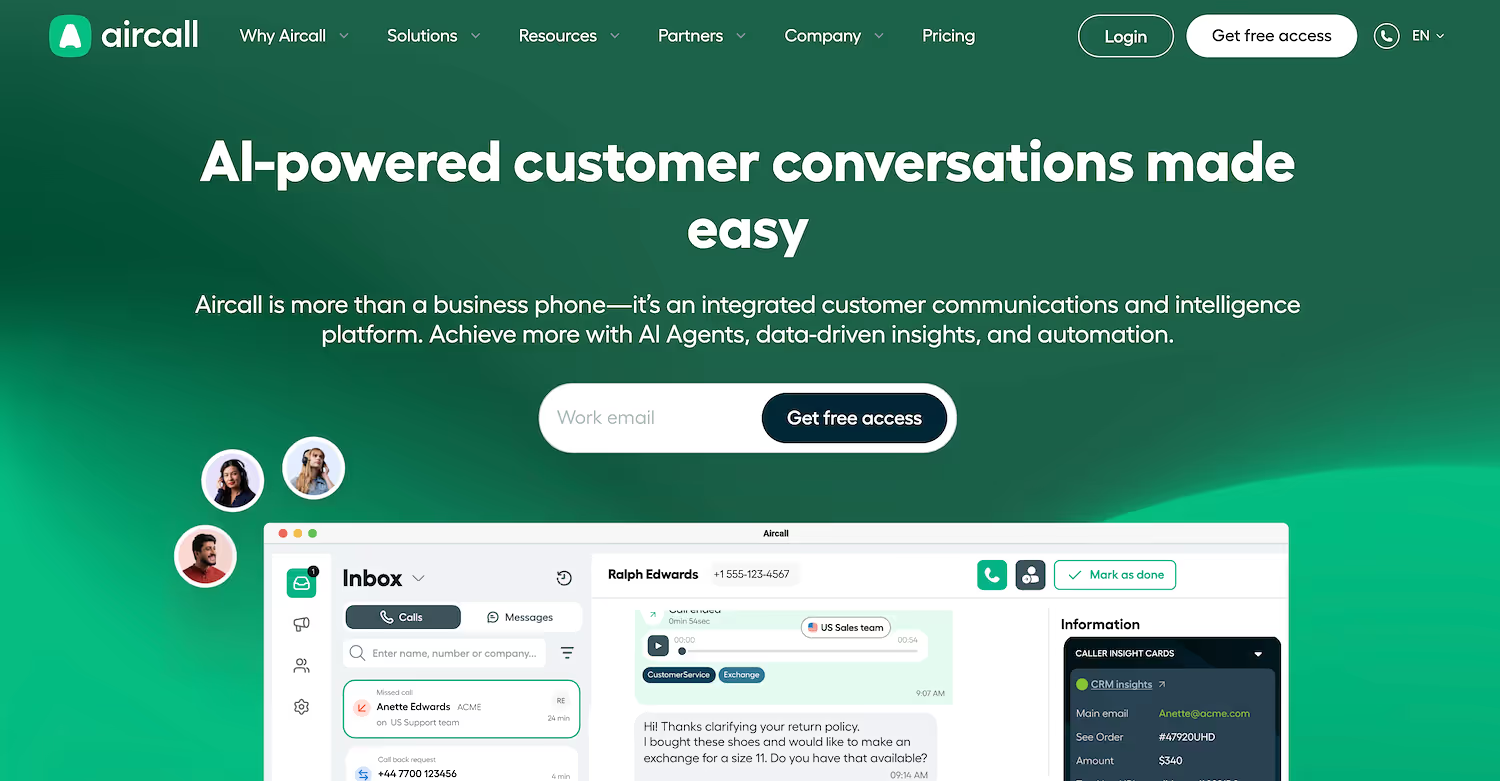
Aircall is a cloud communication platform for sales and support teams. It combines voice, SMS, and WhatsApp into a single workspace. The system supports outbound sales with a Power Dialer and click-to-dial functions. It also provides tools for inbound support, like IVR and smart call routes.
With over 100 integrations, it connects to CRMs and help desks to give context on calls. More than 20,000 companies use the service for their communication needs.
Aircall's Main Features
- Includes an AI Voice Agent that autonomously handles, qualifies, and routes inbound calls.
- Provides real-time coaching during live calls and automates follow-up workflows with its AI Assist feature.
- Unifies calls, SMS, and WhatsApp conversations into a single workspace with powerful analytics to track KPIs and surface trending topics.
How Aircall Compares to OpenPhone
Average Review Score: 4.4/5 stars based on 1,314 G2 reviews.
- Aircall offers over 100 integrations with CRMs and help desks, which provides more extensive workflow automation compared to OpenPhone's simpler connections.
- The platform combines calls, SMS, and WhatsApp into one workspace. This provides teams with more communication channels than OpenPhone, which focuses on calls and texts.
- It includes a Power Dialer for outbound sales campaigns, a feature that automates dialing for sales teams and is not available in OpenPhone's standard offering.
- This tool uses AI for features like live call coaching and automated follow-ups. It offers a different level of support than the standard functions in OpenPhone.
Where Aircall Falls Short
- Aircall's pricing plans require a minimum of three users. This structure is less flexible for solo entrepreneurs or small teams compared to OpenPhone, which offers plans that accommodate single users.
- The platform may have limits on included SMS messages before extra charges apply. This differs from OpenPhone, where unlimited messaging in the US and Canada is a standard feature in its plans.
- Some users report that the interface can feel less integrated than OpenPhone's. For instance, checking missed calls and messages might require switching between separate tabs, unlike OpenPhone's unified inbox view.
Pricing and Cost-Effectiveness
Aircall's pricing starts at $30 per user per month with a required three-user minimum, making its entry point higher than OpenPhone's. This makes OpenPhone a more cost-effective choice for individuals or very small teams. For detailed pricing, visit Aircall's official website.
4) Grasshopper
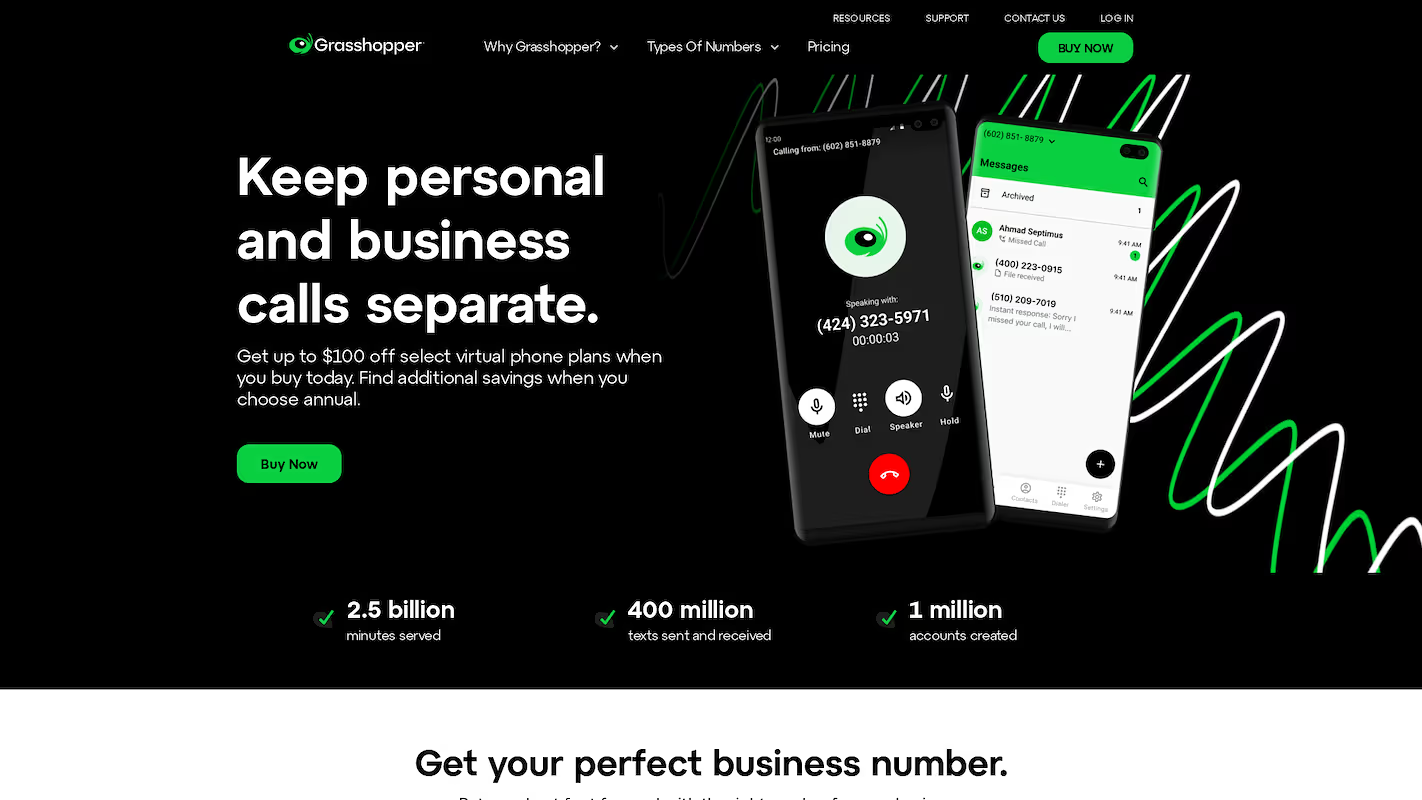
Grasshopper is a virtual phone system built for small businesses. It adds a business line and phone system to your personal phone, which allows entrepreneurs to manage communications. The service helps a small company present a professional image to its customers without the need for complex hardware. It keeps business and personal calls separate on a single device.
Grasshopper's Main Features
- It provides toll-free, vanity, and local business numbers and allows users to port an existing number for free.
- The system includes an instant response feature that sends an automatic text message to any missed callers.
- It offers a virtual fax service that converts incoming faxes into PDF documents and sends them to an email address.
- The platform supports extensions for different employees or departments and offers an add-on for a live virtual receptionist.
How Grasshopper Compares to OpenPhone
Average Review Score: 3.9/5 stars based on 154 G2 reviews.
- Grasshopper offers a virtual fax service, which converts faxes to email PDFs. This is a specific feature for businesses that still use fax, unlike OpenPhone, which focuses on calls and SMS.
- The platform includes unlimited extensions for departments or employees. This setup supports more complex call routing than OpenPhone's simpler shared number system.
- It provides an option to add a live virtual receptionist to answer calls. This service offers a human touch for customer interactions, a different approach from OpenPhone's automated features.
- Its pricing structure includes flat-fee plans that cover multiple users. This contrasts with OpenPhone, which typically charges on a per-user basis.
Where Grasshopper Falls Short
- Grasshopper's system forwards calls and sends voicemail transcriptions to email. This is different from OpenPhone, which provides a unified inbox to manage all calls, texts, and voicemails in one place.
- The tool offers limited options for team collaboration. It does not include internal threads or mentions to discuss customer conversations, a feature that OpenPhone provides to keep teams aligned.
- It does not have a call recording feature. This might be a limitation for businesses that rely on call recordings for training or quality assurance, a function that is standard in OpenPhone.
Pricing and Cost-Effectiveness
Grasshopper's pricing starts at $14 per month for a solo plan. Unlike OpenPhone's per-user pricing, Grasshopper's flat-fee plans for teams can be more cost-effective as you scale. For detailed pricing, visit Grasshopper's official website.
5) Nextiva
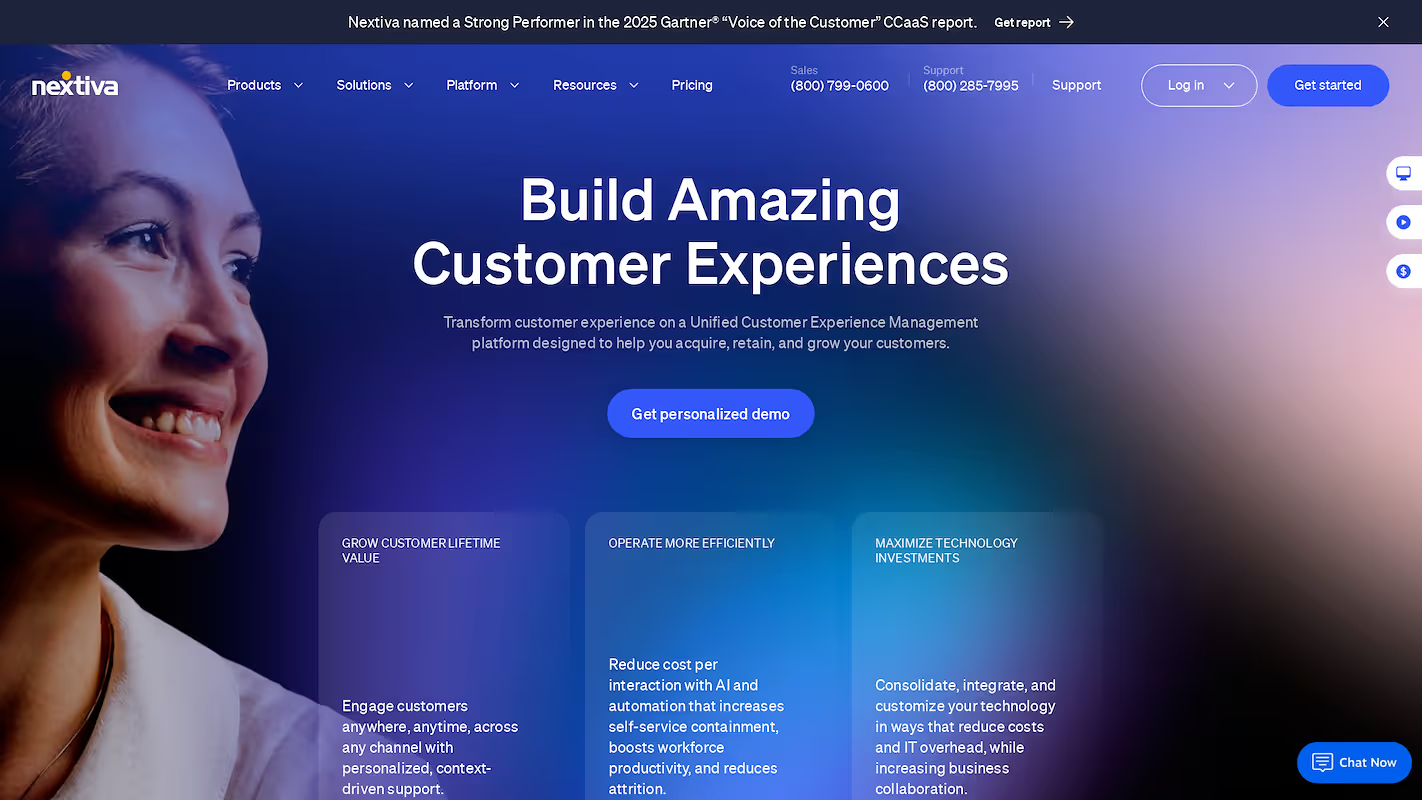
Nextiva is a communication platform for businesses with tools for customer and team interactions. The system connects phone, video, and message services into a single application. This unified solution supports sales and service teams. It is for companies that want to manage all conversations from one place.
Nextiva's Main Features
- Consolidates customer touch-points such as voice, chat, SMS, email, and social media into a single workspace.
- Orchestrates customer journeys from end to end with a patented workflow engine.
- Provides a generative-AI knowledge base, sentiment analysis, and language detection.
How Nextiva Compares to OpenPhone
Average Review Score: 4.5/5 stars based on 3,333 G2 reviews.
- Nextiva consolidates voice, video, and messaging into one platform. This provides more communication channels than OpenPhone, which focuses on calls and SMS.
- It includes AI tools for sentiment analysis and a generative AI knowledge base. This offers deeper customer insights compared to the standard analytics in OpenPhone.
- The platform has a workflow engine to manage customer journeys. This allows for more complex automation than OpenPhone’s simpler integration capabilities.
- This tool offers HIPAA-compliant communication options for businesses in healthcare, a specialized feature not found in more general-purpose phone systems like OpenPhone.
Where Nextiva Falls Short
- Some users report that Nextiva's platform can be complex to navigate. This is different from OpenPhone, which generally offers a more straightforward user interface for managing communications.
- The tool sometimes requires users to contact support to make account changes. In comparison, OpenPhone provides more self-service options that allow users to manage their own settings directly.
- Its pricing and contract terms may be less suitable for small teams. Some users mention issues with auto-renewals, while OpenPhone's plans are often more flexible for individuals and small businesses.
Pricing and Cost-Effectiveness
Nextiva's pricing begins at $20 per user per month, which is higher than OpenPhone's starting plans. The price difference is due to Nextiva's broader feature set, including AI tools and a unified communications platform. For detailed pricing, visit Nextiva's official website.
Automate Outbound Sales With 11x
If your goal is to automate sales functions like outreach and appointment setting, 11x provides a platform with digital workers. These AI agents handle tasks from prospect identification to CRM updates, which lets your team focus on closing deals.
Our platform replaces separate tools for data enrichment and outreach. To see how AI agents can manage your sales process, you can learn more about 11x.
With 11x, we use AI to manage the sales process from start to finish. Our agent Alice identifies accounts and handles outreach, while Julian qualifies prospects and schedules meetings. We replace separate tools for data, outreach, and email warmup with a single platform.
Book a demo to see how it works.
6) 8x8 X Series
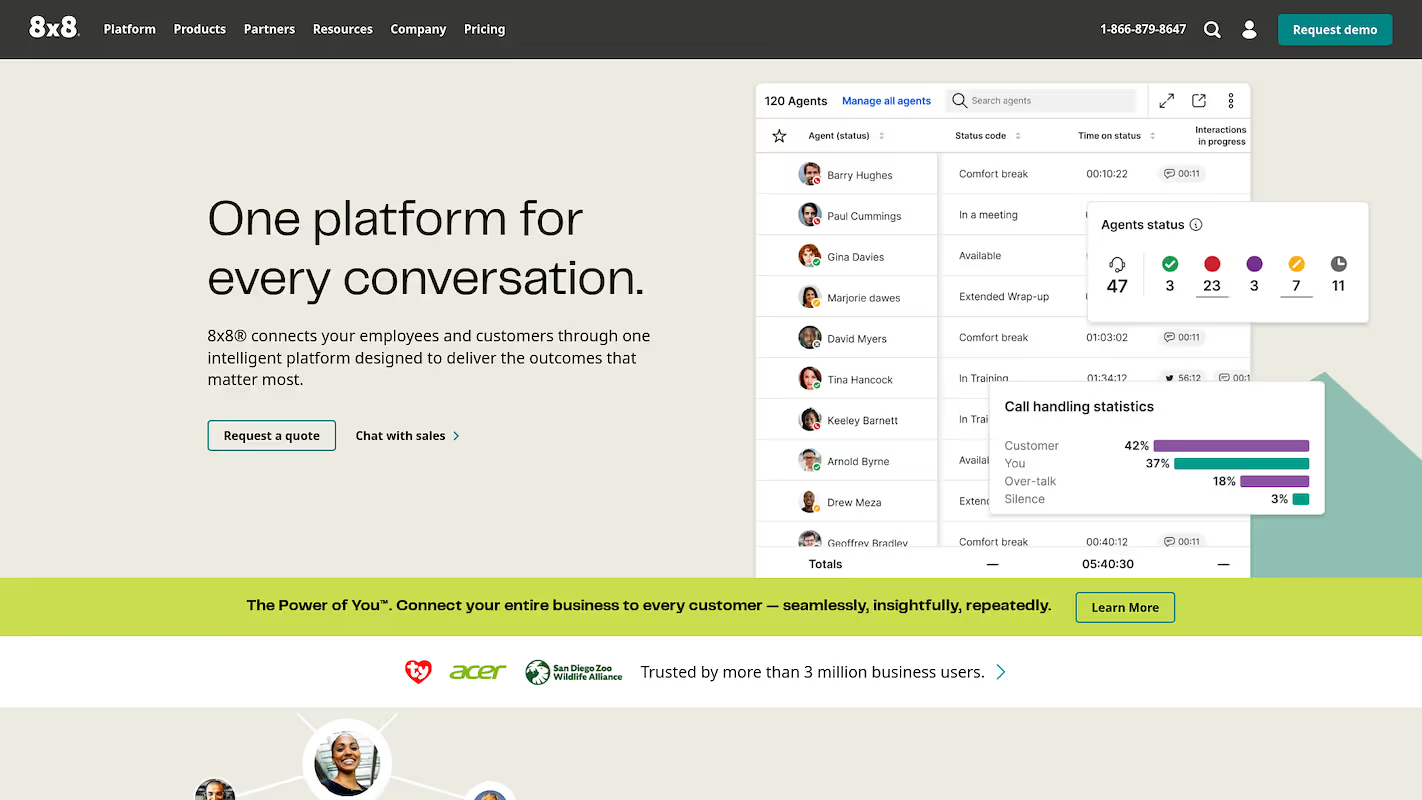
8x8 X Series is a cloud communications platform that combines voice, video, chat, and contact center solutions. It provides a single system for businesses to manage all employee and customer interactions. The platform supports use cases from internal collaboration to external customer service operations.
8x8 X Series's Main Features
- The platform unifies contact center, voice, video, and chat capabilities into a single application driven by AI.
- It offers no-code and low-code APIs to embed communication channels like voice and SMS into other applications.
- The system adds enterprise telephony and contact center functions natively within Microsoft Teams.
- It provides a tool, 8x8 Engage, that equips customer-facing teams outside the contact center with CX tools.
How 8x8 X Series Compares to OpenPhone
Average Review Score: 4.2/5 stars based on 765 G2 reviews.
- 8x8 X Series supports large video meetings with up to 500 participants, a feature not available in OpenPhone, which centers on calls and SMS.
- The platform provides more than 40 integrations with enterprise apps like Salesforce, offering more complex workflow automation than OpenPhone’s simpler connections.
- It offers phone service in over 55 countries. This provides a wider global reach compared to OpenPhone's primary focus on US and Canadian numbers.
- The system includes speech analytics and coaching tools, which give more detailed performance insights than the standard analytics found in OpenPhone.
Where 8x8 X Series Falls Short
- 8x8 X Series can have a longer setup process, with implementation sometimes taking up to two months. This is different from OpenPhone, which offers a faster start for teams that need a simple solution.
- Some users report that the platform's navigation is difficult. Its extensive features can make the interface feel less direct compared to OpenPhone’s simpler design.
- The system is built for enterprise needs and may be too complex for small teams. OpenPhone, in contrast, focuses on providing a straightforward shared number for smaller business use cases.
Pricing and Cost-Effectiveness
8x8 X Series is generally more expensive than OpenPhone, reflecting its enterprise-grade features. For the most accurate pricing based on your team's needs, we recommend visiting the 8x8 X Series's official website.
7) Vonage Business Communications
Vonage Business Communications is a unified communications platform that provides voice, messaging, and video services. It is designed for businesses that need an all-in-one system to manage internal and external communications, moving beyond a simple phone line.
Vonage Business Communications's Main Features
- The platform combines voice, SMS, and video conferencing into a single application.
- It offers an app marketplace with integrations for tools like Salesforce, Microsoft Teams, and Zendesk.
- The system includes advanced call management features, such as a multi-level auto attendant and call recording.
How Vonage Business Communications Compares to OpenPhone
Average Review Score: 4.3/5 stars based on 5,180 G2 reviews.
- Vonage provides a full unified communications suite, including video meetings. This is a broader offering than OpenPhone, which focuses on voice and SMS.
- Its app marketplace allows for more complex workflows through numerous integrations, compared to the more limited connections available with OpenPhone.
- The platform offers enterprise-grade features like a multi-level auto attendant, providing more sophisticated call routing than OpenPhone's system.
Where Vonage Business Communications Falls Short
- Some users report that the mobile app's performance can be inconsistent, which may be a factor for teams that rely on mobile devices for communication.
- The pricing structure can become complex with various add-ons. This is different from OpenPhone, which often presents more straightforward, all-inclusive plans.
- According to user reviews, customer support experiences can be mixed. This might be a consideration for businesses that require consistently responsive support.
Pricing and Cost-Effectiveness
Vonage's pricing starts at $19.99 per line per month, but costs vary based on team size and features. This can make it a larger investment than OpenPhone for small teams. For accurate pricing, visit the official Vonage website.
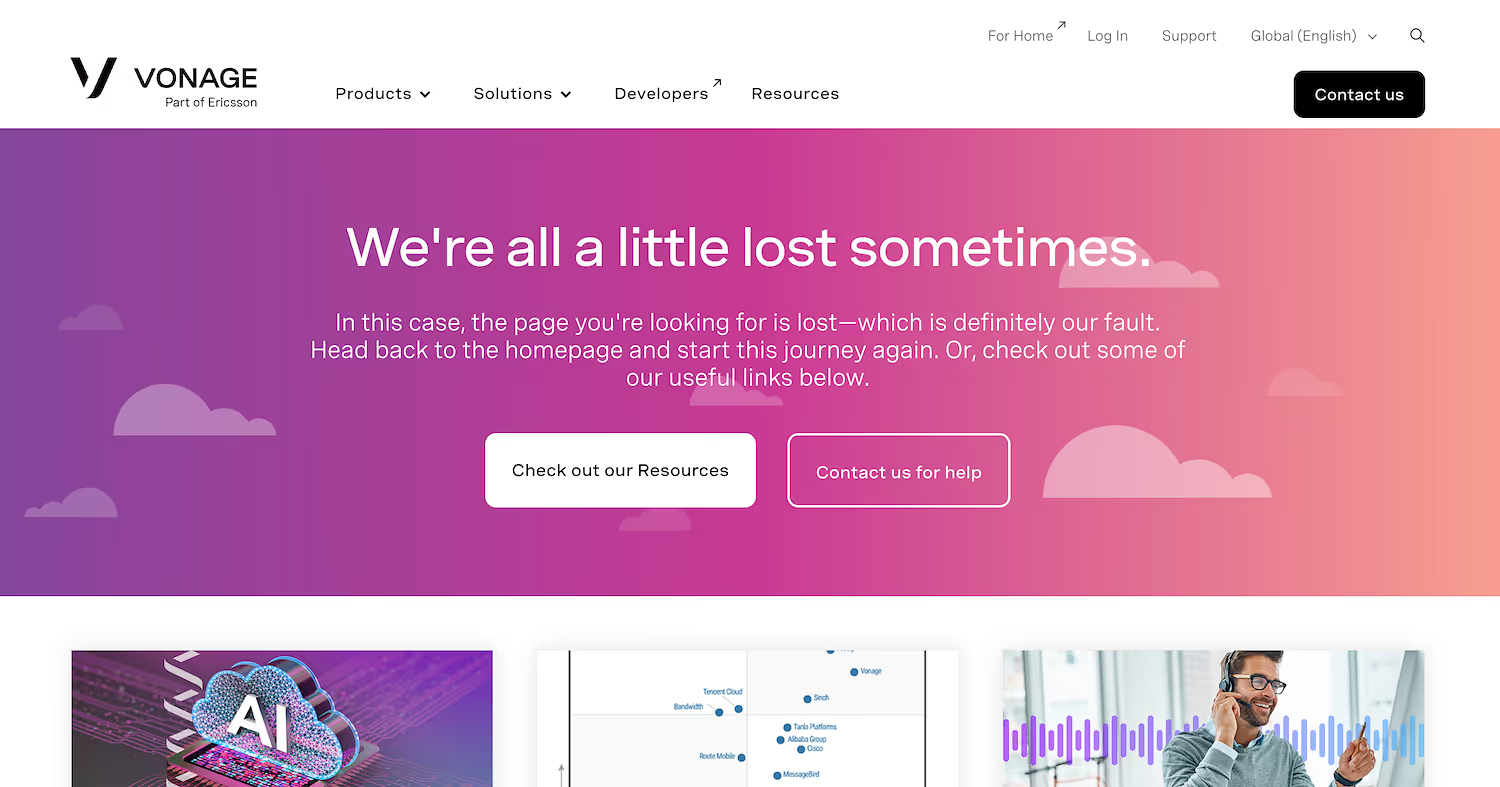
Vonage Business Communications is a unified communications platform with voice, SMS, and video services. It is for businesses that need an all-in-one system for all contact. The platform includes advanced call management and integrates with tools like Salesforce. It offers more than a simple phone line for companies.
Vonage Business Communications's Main Features
- The platform combines voice, SMS, and video conferencing into a single application.
- It offers an app marketplace with integrations for tools like Salesforce, Microsoft Teams, and Zendesk.
- The system includes advanced call management features, such as a multi-level auto attendant and call recording.
How Vonage Business Communications Compares to OpenPhone
Average Review Score: 4.3/5 stars based on 484 G2 reviews.
- Vonage Business Communications includes video calls within its platform. This provides a unified tool for meetings, unlike OpenPhone, which centers on voice and text communication.
- It offers advanced call features like an automated attendant. This allows for more complex call routing for different departments compared to OpenPhone's simpler shared number system.
- The platform guarantees 99.999% uptime reliability. This offers a higher level of service assurance for business continuity than what is typically found with simpler phone systems.
- This tool supports communication globally. It allows businesses to connect with customers and teams worldwide, a broader reach than OpenPhone's primary focus on US and Canadian numbers.
Where Vonage Business Communications Falls Short
- Some users report that the mobile app's performance can be inconsistent, which may be a factor for teams that rely on mobile devices. This is different from OpenPhone, which is often noted for its reliable mobile experience.
- The tool lacks specific collaboration features like internal threads to discuss customer conversations. In contrast, OpenPhone provides a shared inbox built for team collaboration around calls and messages.
- Its pricing structure can become complex with various add-ons for features. OpenPhone, on the other hand, typically offers more straightforward plans where core functions are included without extra charges.
Pricing and Cost-Effectiveness
Vonage's pricing starts at $19.99 per line per month, making it a larger investment than OpenPhone, especially for small teams. Costs vary based on features and team size, so for the most accurate pricing, visit the official Vonage website.
8) CloudTalk

CloudTalk is an AI-powered cloud phone system for sales and support teams. The platform offers tools like a Power Dialer and smart call distribution to manage business communications. It is for companies that want to improve sales and customer service interactions.
The system provides international numbers in over 160 countries and connects with popular CRMs and help desks.
CloudTalk's Main Features
- The platform provides session routing and queuing to manage call distribution.
- It supports concurrent calling, which allows agents to handle multiple calls at the same time.
- It includes administrative functions like session summary notes, administrator access, and reporting dashboards.
How CloudTalk Compares To OpenPhone
Average Review Score: 4.4/5 stars based on 1,384 G2 reviews.
- CloudTalk provides international numbers in over 160 countries. This gives it a wider global reach than OpenPhone, which focuses on US and Canadian numbers.
- It includes a Power Dialer to automate outbound sales calls, a feature for high-volume teams that OpenPhone does not offer.
- The platform supports concurrent calling, which allows agents to handle multiple calls at the same time. This differs from OpenPhone's design for one-on-one conversations.
- This tool offers AI-powered coaching and call transcripts. These features provide deeper insights into conversations compared to the standard analytics in OpenPhone.
Where CloudTalk Falls Short
- CloudTalk does not offer a shared inbox with internal threads for team collaboration. This is different from OpenPhone, where teams can discuss customer conversations directly within the app.
- Some users mention occasional call or connection problems. This contrasts with OpenPhone, which is often noted for its reliable performance, especially on its mobile application.
- The platform's plans might include limits or extra fees for SMS messages. This differs from OpenPhone, where unlimited texting in the US and Canada is a standard feature.
Pricing and Cost-Effectiveness
CloudTalk's starter plan is priced annually at $19 per user, which can be a lower initial investment compared to OpenPhone's per-user monthly plans. For detailed costs and features included in each tier, visit CloudTalk's official website.
9) GoTo Connect
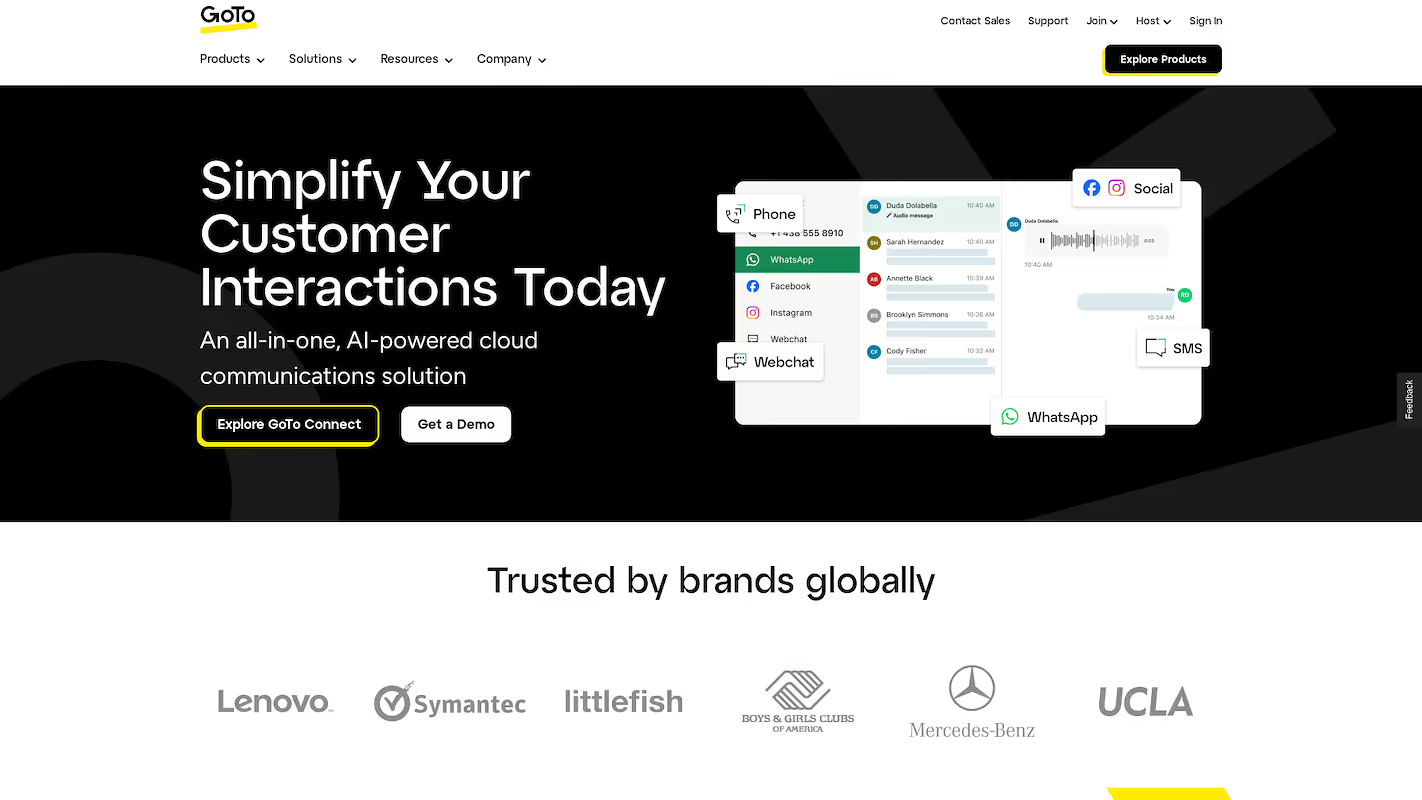
GoTo Connect is a unified cloud platform for business communications. It combines a phone system, video meetings, and chat in one application. The system supports hybrid work models.
It includes contact center tools such as call queues and specific routes for calls to manage customer conversations. The platform is for companies that want all communication tools in one place.
GoTo Connect's Main Features
- The platform includes a built-in AI receptionist to welcome callers and automate call routing.
- It combines phone calls, video meetings, and instant messaging into a single application.
- The system provides advanced call management features, including a visual dial plan editor and automated attendants.
How GoTo Connect Compares To OpenPhone
Average Review Score: 4.4/5 stars based on 1,339 G2 reviews.
- GoTo Connect combines phone, video, and chat into one application. This offers more communication channels compared to OpenPhone, which focuses on calls and SMS.
- It includes a built-in AI receptionist to automate call routing. This provides a different level of automation than the standard call distribution in OpenPhone.
- The platform provides a visual dial plan editor for custom call flows. This allows for more complex routing setups than OpenPhone's simpler system.
- This tool guarantees 99.999% uptime for service reliability. This offers a specific service level agreement not typically found with simpler phone systems like OpenPhone.
Where GoTo Connect Falls Short
- GoTo Connect does not offer a shared inbox with internal threads for team collaboration. This is different from OpenPhone, where teams can discuss customer conversations directly within the application.
- Some users report that its interface can be complex due to the number of features. In comparison, OpenPhone provides a more streamlined user experience focused on core communication tasks.
- The platform's feature set and pricing may be more than what a small business needs. OpenPhone offers simpler plans that are often more cost-effective for solo entrepreneurs or small teams.
Pricing and Cost-Effectiveness
GoTo Connect's pricing starts at $27 per user per month, making it a more expensive option than OpenPhone, which offers more cost-effective plans for small businesses. For detailed pricing information, visit the GoTo Connect's official website.
10) Phone.com
Phone.com is a cloud phone service for small to mid-sized businesses. It provides VoIP communication features, including voice, text, and video meetings. The platform is designed as a flexible phone system that adapts to different business needs and sizes.
Phone.com's Main Features
- The platform offers business phone numbers, including local, toll-free, and vanity numbers.
- It includes video conferencing with features like screen sharing and meeting recording.
- The system provides HIPAA-compliant communication options for businesses in the healthcare industry.
How Phone.com Compares to OpenPhone
- Phone.com offers mix-and-match user plans, allowing different feature sets for each team member. This provides more pricing flexibility than OpenPhone's uniform per-user plans.
- It includes video conferencing as part of its service. This makes it a more unified tool for businesses that need voice and video, unlike OpenPhone's focus on calls and SMS.
- The platform provides HIPAA-compliant plans, a specific requirement for healthcare businesses that is not a standard feature in OpenPhone.
Where Phone.com Falls Short
- Some users find its interface less modern than OpenPhone's design. This can result in a steeper learning curve for teams that prefer a more streamlined user experience.
- Its team collaboration features are not as integrated as OpenPhone's shared inbox. Discussing customer calls and messages with teammates is less direct.
- The platform does not offer unlimited calling to the US and Canada on its base plans. This is a key difference from OpenPhone, where it is a standard feature.
Pricing and Cost-Effectiveness
Phone.com's pricing is based on a per-user model with different tiers. While its base plans can be competitive, costs can increase with add-ons. This model may be less straightforward than OpenPhone's all-inclusive plans. For accurate pricing, visit the official Phone.com website.
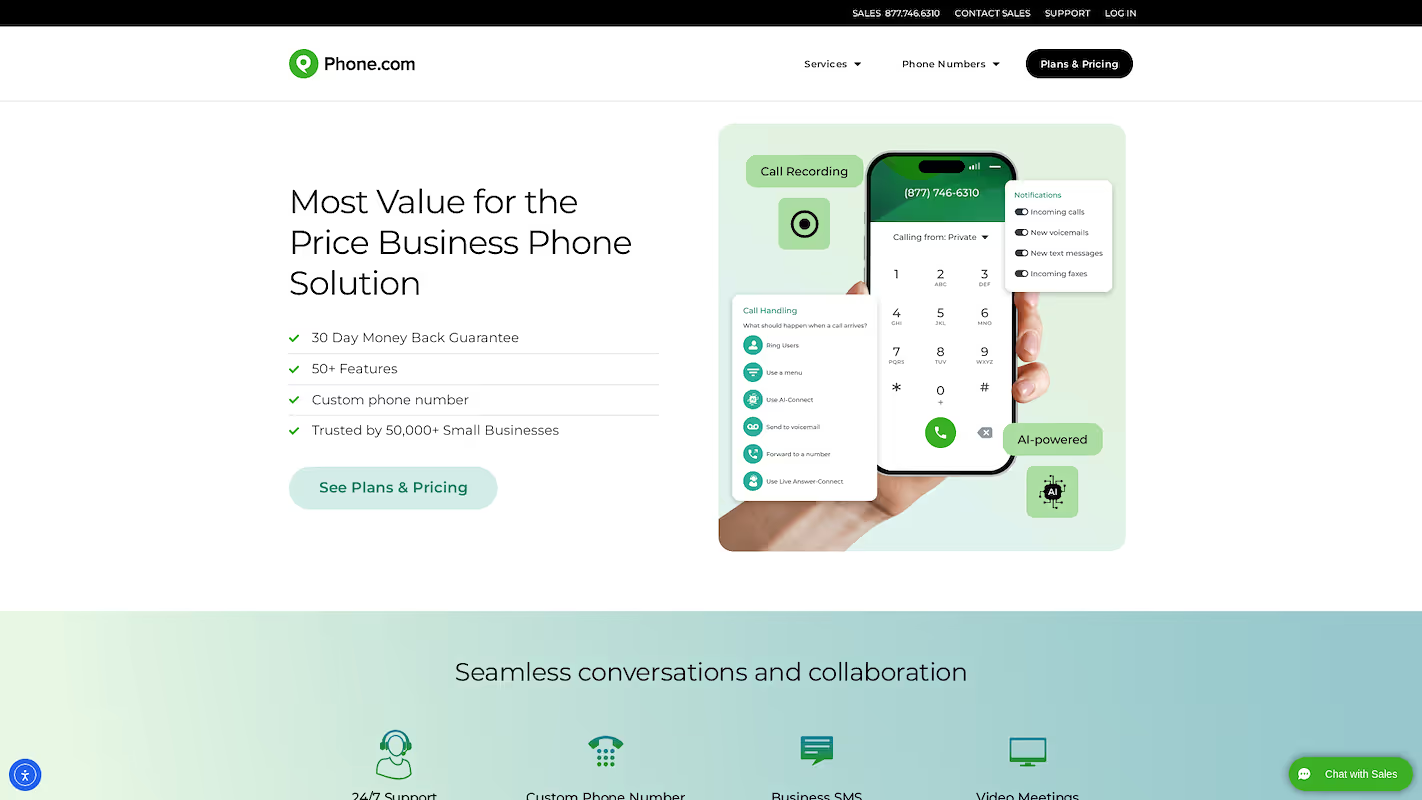
Phone.com is a cloud phone service for small to mid-sized businesses. It provides VoIP communication with voice, text, and video meetings. The platform offers a flexible phone system that adapts to different business needs, with options for HIPAA compliance.
Phone.com's Main Features
- The platform includes conference calling for group discussions.
- It provides hold music for callers who are waiting.
- The system offers automated attendants to direct incoming calls.
How Phone.com Compares To OpenPhone
Average Review Score: 3.5/5 stars based on 33 G2 reviews.
- Phone.com allows mix-and-match user plans, so each team member can have a different feature set. This offers more pricing flexibility compared to OpenPhone's uniform per-user plans.
- It includes video conferencing as part of its service, which makes it a more unified tool for meetings than OpenPhone's focus on voice and SMS.
- The platform provides HIPAA-compliant plans for the healthcare industry. This is a specific feature for compliance that OpenPhone does not offer in its standard plans.
- This tool includes features like hold music and automated attendants to direct callers. This provides more advanced call-handling options compared to OpenPhone's simpler system.
Where Phone.com Falls Short
- Phone.com does not offer a shared inbox for teams to add internal notes to conversations. This makes collaboration less direct compared to OpenPhone, which centers its workflow around a shared team workspace.
- Some users report that its mobile app can interfere with native phone calls or Bluetooth devices. This is different from OpenPhone, which is often noted for a mobile experience that works smoothly with the device.
- The platform's base plans come with limits on minutes and text messages. This contrasts with OpenPhone, where unlimited usage in the US and Canada is a standard feature, providing more predictable monthly costs.
- According to some reviews, the service may have occasional call drops or connectivity issues. This can be a factor for businesses that rely on consistent call quality, an area where OpenPhone generally receives positive feedback.
Pricing and Cost-Effectiveness
Phone.com's Basic plan starts at $14.99 per user per month, but this comes with usage limits, unlike OpenPhone's all-inclusive plans which offer more predictable costs. For detailed pricing information, visit Phone.com's official website.
Which One Should You Go With?
Many variables factor into choosing an OpenPhone alternative, from team size to required features. This guide reviewed several options to help you find a suitable platform for your business needs.
If your goal is to automate sales functions instead of managing general business calls, 11x offers a different approach. Our platform uses digital workers to handle outbound prospecting and appointment setting, allowing your sales team to focus on closing deals.


